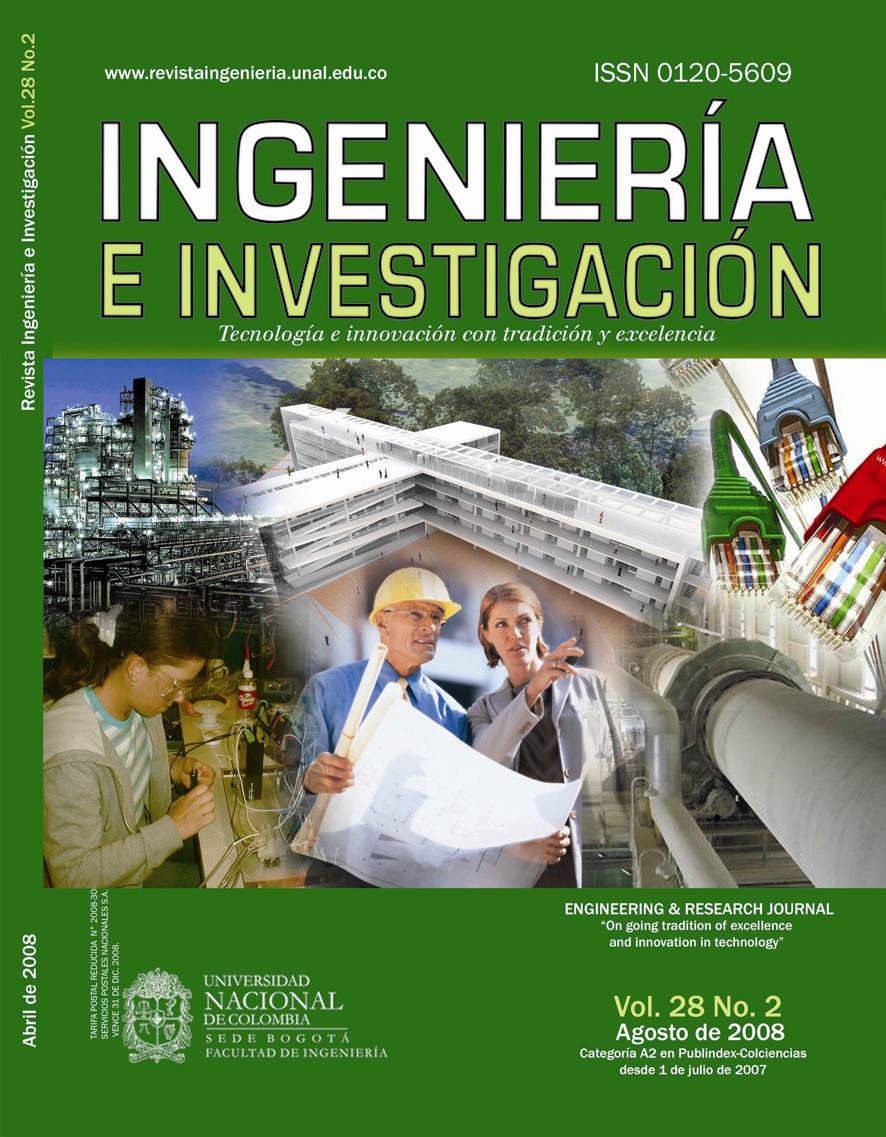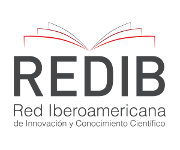A study of coal-solid waste blend reactivity
Estudio de reactividad de mezclas de residuos sólidos - carbón
DOI:
https://doi.org/10.15446/ing.investig.v28n2.14904Keywords:
co-combustion, coal, biomass, reactivity, thermal analysis (en)co-combustión, carbón, biomasa, reactividad, análisis térmico (es)
Downloads
The Flynn-Wall-Ozawa method was used for analysing coal-solid waste blend reactivity in an oxidising atmosphere. The presence of biomass strongly affected coal combustion kinetics when the blend contained more than 30% of it. Activation energy values (evaluated by different blends) were 28.7495 kJ/mol for 0% biomass, 31.3915 kJ/mol for 30% biomass, 39.0365 kJ/mol for 50% biomass, 102.431 kJ/mol for 70% biomass and 107.8075 kJ/mol for 100% biomass; these values were close to those reported in the literature. First-order kinetics correlated the data very well for the 100% coal sample and the blend having 30% biomass and 70% coal. Eighth-order kinetics were more suitable for correlating the experimental data for the 70% biomass-30% coal blend and the 100% biomass sample. Combustion was done without previous pyrolysis of the blends; however segregation of phenomena could be appreciated. This seems to indicate that combustion and devolatilisation are independent processes which should be taken into account when building equipment using these kinds of blend.
La reactividad de mezclas de residuos sólidos y carbón en atmósfera oxidante fue analizada usando el método de Flynn Wall Ozawa. La cinética de la combustión es fuertemente afectada por la presencia de biomasa, cuando la relación en la mezcla es superior al 30%. Los valores de la energía de activación evaluados para diferentes mezclas fueron: 28.7495 kJ/mol para 0% de biomasa, 31.3915 kJ/mol para 30% de biomasa, 39.0365 kJ/mol para 50% de biomasa, 102.431 kJ/mol para 70% de biomasa y 107.8075 kJ/mol para 100% de biomasa. Estos valores son cercanos a los reportados en la literatura. Se encontró también que para la muestra de carbón al 100% y la mezcla de 30% biomasa y 70% de carbón una cinética de primer orden correlaciona muy bien los datos; mientras que para la mezcla de 70% biomasa 30% carbón y la muestra de 100% biomasa, una cinética de orden 8 es más adecuada para correlacionar los datos experimentales. La combustión se hizo sin la pirólisis previa de las muestras; sin embargo, es posible apreciar una división del fenómeno. Esto parece indicar que la combustión y la devolatilización son procesos independientes, lo cual es importante en la construcción de equipos para este tipo de mezclas.
References
Biagini, E., Lippi F., Petarca L., Tognotti, L., Devolatilization rate of biomasses and coal- biomass blends: an
experimental investigation., Fuel 81, 2002, pp. 1041- 1050. DOI: https://doi.org/10.1016/S0016-2361(01)00204-6
Calvo, L.F., Otero, M., Jenkins, B.M., Moran, A., García, A. I., Heating process characteristics and Kinetics of rice straw in different atmospheres., Fuel Processing Technology, 85, 2004, pp. 279– 291 DOI: https://doi.org/10.1016/S0378-3820(03)00202-9
Defeche, J., Tratamiento De Los Residuos. Incineración y Valoración Energética de la Basura., Coloquio Sobre Residuos Sólidos, Sociedad Venezolana de Ciencias Naturales, 1980.
Di Blasi, C., Buonanno, F., Branca, C., Reactivities of some biomass chars in air.
Gayana, P., Adaneza, J., De Diego a, L. F., García, F., Cabanillas, A., Bahillo, A., HOAC, A., Veijonen, K., Circulating fluidised bed co-combustion of coal and biomass., Fuel 83, 2004, pp. 277–286 DOI: https://doi.org/10.1016/j.fuel.2003.08.003
Folgueras, M. B., Díaz, R., Liberta, J., Prieto, I., Thermogravimetric analysis of coal and sewage sludge., Fuel 82, 2003, pp. 2051- 2055. DOI: https://doi.org/10.1016/S0016-2361(03)00161-3
Fraga, G. L., Estudio Cinético, Dinanomecánico y termogravimétrico del Sistema Epoxídico BADGE (n= 0) /m´XDA, mediante las técnicas de análisis térmico: DSC, DMA y TGA., Construcción de un diagrama TTT, Tesis Doctoral, Universidad de Santiago de Compostela, 2001.
Johannes, O. J., Kinetics Analysis using multivariate Non – linear Regression., Thermal Anal, Cal. 60, 2000, pp. 641- 658. DOI: https://doi.org/10.1023/A:1010167626551
Kristiansen, A., Understanding coal gasification IEA., in IEA Coal Research, 1996, pp. 17-23.
Romero, S. A., Incineración de Residuos Sólidos Urbanos., Dpto. de Ingeniería Química. Facultad de CC. Químicas, Universidad Complutense de Madrid, 2002. URL: http://www.esi.us.es/AICIA/1997/inter.html.
Sima-Ella, E., Yuan, G., Mays, T., A simple kinetic analysis to determine the intrinsic reactivity of coal chars., Fuel, 84, 2005, pp. 1920-1925. DOI: https://doi.org/10.1016/j.fuel.2005.03.022
Vyazovkin, S., Wight Charles A. Model-free and model fitting approaches to kinetic analysis of isothermal and no isothermal data Thermochimica Acta 340 – 341., 1999, pp. 53- 68. DOI: https://doi.org/10.1016/S0040-6031(99)00253-1
Vuthaluru, H. B., Investigations into the pyrolytic behaviour of coal/biomass blends using thermogravimetric analysis., Bioresource Technology, 92, 2004, pp. 187 – 195. DOI: https://doi.org/10.1016/j.biortech.2003.08.008
How to Cite
APA
ACM
ACS
ABNT
Chicago
Harvard
IEEE
MLA
Turabian
Vancouver
Download Citation
CrossRef Cited-by
1. Josep O. Pou, Yesica E. Alvarez, Justin K. Watson, Jonathan P. Mathews, Sarma Pisupati. (2012). Co-primary thermolysis molecular modeling simulation of lignin and subbituminous coal via a reactive coarse-grained simplification. Journal of Analytical and Applied Pyrolysis, 95, p.101. https://doi.org/10.1016/j.jaap.2012.01.013.
Dimensions
PlumX
Article abstract page views
Downloads
License
Copyright (c) 2008 Nayibe Guerrero, Anyela Guzmán, Diana Milena Montoya, Carlos Londoño, Farid Chejne Janna

This work is licensed under a Creative Commons Attribution 4.0 International License.
The authors or holders of the copyright for each article hereby confer exclusive, limited and free authorization on the Universidad Nacional de Colombia's journal Ingeniería e Investigación concerning the aforementioned article which, once it has been evaluated and approved, will be submitted for publication, in line with the following items:
1. The version which has been corrected according to the evaluators' suggestions will be remitted and it will be made clear whether the aforementioned article is an unedited document regarding which the rights to be authorized are held and total responsibility will be assumed by the authors for the content of the work being submitted to Ingeniería e Investigación, the Universidad Nacional de Colombia and third-parties;
2. The authorization conferred on the journal will come into force from the date on which it is included in the respective volume and issue of Ingeniería e Investigación in the Open Journal Systems and on the journal's main page (https://revistas.unal.edu.co/index.php/ingeinv), as well as in different databases and indices in which the publication is indexed;
3. The authors authorize the Universidad Nacional de Colombia's journal Ingeniería e Investigación to publish the document in whatever required format (printed, digital, electronic or whatsoever known or yet to be discovered form) and authorize Ingeniería e Investigación to include the work in any indices and/or search engines deemed necessary for promoting its diffusion;
4. The authors accept that such authorization is given free of charge and they, therefore, waive any right to receive remuneration from the publication, distribution, public communication and any use whatsoever referred to in the terms of this authorization.



























